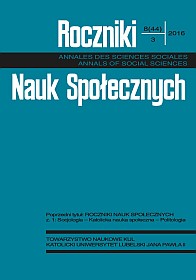The role of image in ritual media communication based on the example of Polish news bulletins
Abstract
The article presents some questions connected with the role of image in ritual communication based on the example of polish news bulletins. I focused my analyse on this kind of programme, because of its popularity. The aim of this research is to analyse the usage of visual content of news bulletins and its role in the perception of information. Images are also important from the perspective of ritual communication. They strengthen the verbal message and broaden the control mechanisms over the recipient. There are several question that can be asked here. What pictures are used to convey message? In what context they appear? How the usage of picture changes according to a kind of the presented information? What is the relation between verbal and visual message?
References
Bergström B.: Komunikacja wizualna, Warszawa: Wydawnictwo Naukowe PWN 2009.
Blondheim M.: Liebes T., Live Television’s Disaster Marathon of September 11 and its Subversive Potential, “Prometheus”, 20 (2002), No 3.
Bourdieu P.: O telewizji. Panowanie dziennikarstwa, Warszawa: Wydawnictwo Naukowe PWN 2011.
Boyd A.: Dziennikarstwo radiowo-telewizyjne: techniki tworzenia programów informacyjnych, Kraków: Wyd. UJ 2006.
Carey J.: Communication as a Culture – Essays on Media and Society, New York–London: Routledge 1992.
Curran J.: Liebes T.: The Intellectual Legacy of Elihu Katz, in: Media, Ritual and Identity, eds. T. Liebes, J. Curran, London–New York: Routledge 2008.
Cury I.: Directing and Producing for Television. A Format Approach, Amsterdam [etc.]: Elsevier 2011.
Dayan D., Katz E.: Wydarzenia medialne. Historia transmitowana na żywo, Warszawa: Muza 2008.
Drozdowski R.: Obraza na obrazy. Strategie społecznego oporu wobec obrazów dominujących, Poznań: Wyd. UAM 2006.
Foucault M.: Słowa i rzeczy. Archeologia nauk humanistycznych, Gdańsk: Słowo/obraz terytoria 2000.
Godzic W.: Wstęp do wydania polskiego, in: Wydarzenia medialne. Historia transmitowana na żywo, D. Dayan, E. Katz, Warszawa: Muza 2008.
Gombrich E.H.: Obraz wizualny, in: Symbole i symbolika, ed. M. Głowiński, Warszawa: Czytelnik 1991.
Katz E., Liebes T.: „No more peace!”. Disaster, Terror, War and Media Evens, in: Media Events in a Global Age, eds. N. Couldry, A. Hepp, F. Krotz, New York: Routledge 2010.
Kociuba M.: Antropologia poznania obrazowego. Rola obrazu i dyskursu w poznawczym ujmowaniu świata, Lublin: Wyd. UMCS 2010.
Kołodziejczak M., Stępińska A.: Teoretyczne podstawy badań nad wydarzeniami medialnymi, „Zeszyty Prasoznawcze” 2014, No 1 (217).
Mitchell W.J.: Iconology, Image, Text, Ideology, Chicago–London: The University of Chicago Press 1986.
Pisarek W.: Język w mediach i media w języku, in: Język w mediach masowych, eds. J. Bralczyk, K. Kosiołek-Mosińska, Warszawa: Wydawca Upowszechnianie Nauki – Oświata „UN-O” 2000.
Raport KRRiT: Najpopularniejsze audycje w I kw. 2014. Dobowa oglądalność programów; http://www.krrit.gov.pl/Data/Files/_public/pliki/publikacje/rapory/kontrola-nadawcow-wynikibadan /najpopularniejszeaudycje-w-i-kw-2014--dobowa-ogladalnosci-programow.pdf [07.08.2014].
Rothenbuhler E.W.: Komunikacja rytualna: od rozmowy codziennej do ceremonii medialnej, Kraków: Wyd. UJ 2003.
Sartori G.: Homo videns. Telewizja i postmyślenie, Warszawa: Wyd. UW 2007.
Silcock B.W., Heider D., Rogus M.T.: Managing Television News. A Handbook for Ethical and Effective Producting, London: Lawrence Erlbaum Associates 2007.
Stępińska A.: 9/11 and the Transformation of Globalized Media Events, in: Media Events in Global Age, eds. N. Couldry, A. Hepp, F. Klotz, London–New York: Routledge 2010.
West D. M.: Air Wars. Television Advertising in the Election Campaign 1952-2008, Washington: CQ Press 2010.
Copyright (c) 2016 Roczniki Nauk Społecznych

This work is licensed under a Creative Commons Attribution-NonCommercial-NoDerivatives 4.0 International License.


